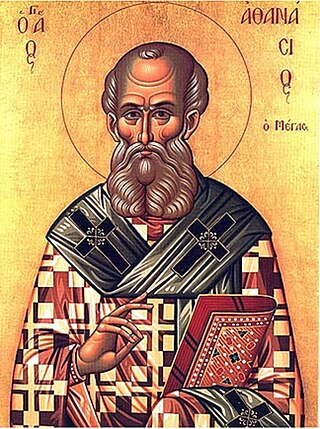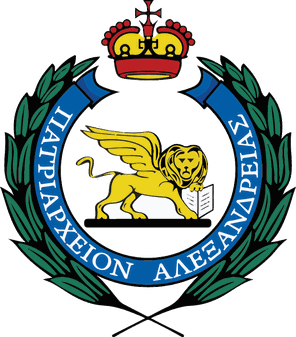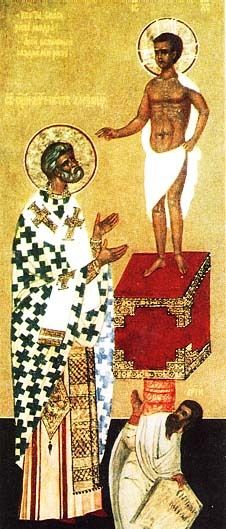Related Research Articles

Athanasius I of Alexandria, also called Athanasius the Great, Athanasius the Confessor, or, among Coptic Christians, Athanasius the Apostolic, was a church father and the 20th pope of Alexandria. His intermittent episcopacy spanned 45 years, of which over 17 encompassed five exiles, when he was replaced on the order of four different Roman emperors. Athanasius was a Christian theologian, a Church Father, the chief defender of Trinitarianism against Arianism, and a noted Egyptian Christian leader of the fourth century.
Eusebius of Nicomedia was an Arian priest who baptized Constantine the Great on his deathbed in 337. A fifth-century legend evolved that Pope Sylvester I was the one to baptize Constantine, but this is dismissed by scholars as a forgery 'to amend the historical memory of the Arian baptism that the emperor received at the end of his life, and instead to attribute an unequivocally orthodox baptism to him.' He was a bishop of Berytus in Phoenicia. He was later made the bishop of Nicomedia, where the Imperial court resided. He lived finally in Constantinople from 338 up to his death.
The 310s decade ran from January 1, 310, to December 31, 319.

Year 313 (CCCXIII) was a common year starting on Thursday of the Julian calendar. At the time, it was known as the Year of the Consulship of Constantinus and Licinianus. The denomination 313 for this year has been used since the early medieval period, when the Anno Domini calendar era became the prevalent method in Europe for naming years. This year is notable for ending of the persecution of Christians in the Roman Empire.
The 330s decade ran from January 1, 330, to December 31, 339.

Arius was a Cyrenaic presbyter, ascetic, and priest associated with the doctrine of Arianism. His teachings about the nature of the Godhead in Christianity, which emphasized God the Father's uniqueness and Christ's subordination under the Father, and his opposition to what would become the dominant Christology made him a primary topic of the First Council of Nicaea convened by Emperor Constantine the Great in 325.

Pope Heraclas was the 13th Pope and Patriarch of Alexandria, reigning 232–248.
Patriarch Peter II of Alexandria was the 21st Patriarch of Alexandria from AD 373 to AD 381. He was a disciple of Athanasius of Alexandria who designated him as his successor before his death in 373.
Pope Peter III of Alexandria also known as Peter Mongus was the 27th Pope of Alexandria and Patriarch of the See of St. Mark.
Pope Athanasius II of Alexandria, 28th Pope of Alexandria & Patriarch of the See of St. Mark.

Alexander I of Alexandria was the 19th Pope and Patriarch of Alexandria. During his patriarchate, he dealt with a number of issues facing the Church in that day. These included the dating of Easter, the actions of Meletius of Lycopolis, and the issue of greatest substance, Arianism. He was the leader of the opposition to Arianism at the First Council of Nicaea. He also mentored his successor, Athanasius of Alexandria, who would become one of the Church Fathers.

The Greek OrthodoxPatriarchate of Alexandria and all Africa, also known as the Greek Orthodox Church of Alexandria, is an autocephalous patriarchate that is part of the Eastern Orthodox Church. Its seat is in Alexandria and it has canonical responsibility for the entire African continent.
The Melitians, sometimes called the Church of the Martyrs, were an early Christian sect in Egypt. They were founded about 306 by Bishop Melitius of Lycopolis and survived as a small group into the eighth century. The point on which they broke with the larger Catholic church was the same as that of the contemporary Donatists in the province of Africa: the ease with which lapsed Christians were received back into communion. The resultant division in the church of Egypt is known as the Melitian schism.

Patriarch Gregory II Youssef, also known as Gregory II Hanna Youssef-Sayour, was Patriarch of the Melkite Greek Catholic Church from 1864 to 1897. Gregory expanded and modernized the church and its institutions and participated in the First Vatican Council, where he championed the rights of the Eastern Catholic Churches.

Pope Peter I of Alexandria was the 17th Pope and Patriarch of Alexandria. He is revered as a saint by the Coptic Orthodox Church, the Eastern Orthodox Church, and the Catholic Church.

Baucalis, also called Boukolou, and Baukalis, is a section in Alexandria, Egypt where St. Mark was reported to have been martyred, along with the historic location of his martyrium. It is also where Arius was a Christian presbyter and priest.
Athanasius I Gammolo was the Patriarch of Antioch and head of the Syriac Orthodox Church from 594/595 or 603 until his death in 631. He is commemorated as a saint by the Syriac Orthodox Church in the Martyrology of Rabban Sliba, and his feast day is 3 January.
References
- 1 2 Atiya, Aziz S. The Coptic Encyclopedia. New York:Macmillan Publishing Company, 1991. ISBN 0-02-897025-X.
- ↑ Monks of Ramsgate. “Achillas”. Book of Saints, 1921. CatholicSaints.Info. 30 April 2012